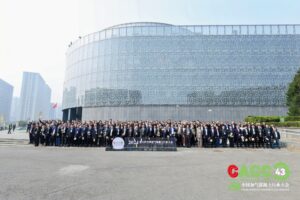— How AAC is made
Autoclaved Aerated Concrete (AAC) is a lightweight, yet strong and durable building material that offers ultra-efficient thermal insulation, optimum fire protection, and a high load-bearing capacity.
The first AAC production started in 1929 in Europe and
it is now produced in a wide range of formats, from blocks to large wall, floor and roof panels. Due to its light weight (20% of the weight of conventional concrete), AAC products are easy to handle, cut and shape with standard tools. Construction times are typically 2-5 times faster with AAC than conventional methods. AAC is also durable and long-lasting with a reference service life of 150 years.
AAC has become one of the most widely used building products around the world for residential, commercial
and industrial construction. In Europe, AAC volumes are
expected to remain steady at around 17.5 million m3 per
year for the forseeable future.
Production Process
AAC is made from cement, lime, fine sand, other siliceous materials, gypsum, water and a small amount of aluminium powder (manufactured from a by-product of aluminium). When AAC is mixed and cast in forms, several chemical reactions take place that give AAC its light weight and thermal properties:
In the alkaline raw materials mixture, aluminium particles react to form millions of microscopic hydrogen bubbles.
The hydrogen gas foams and increases the volume of the raw mix creating bubbles up to 3 millimetres in diameter, causing it to rise like bread dough.
At the end of the foaming process, the hydrogen escapes into
the atmosphere and is replaced by air, which makes 60-85% of the volume of AAC.
When the AAC cake is removed from the mould, it is solid but still soft. It is then cut into either blocks or elements and placed in an autoclave chamber where it is subjected to high pressure, saturated steam typically for 6 to 12 hours.
During this steam pressure hardening process, when the temperature reaches 190 °C and the pressure reaches 800
to 1,200 kPa, quartz sand reacts with calcium hydroxide to
form calcium silicate hydrates – in particular tobermorite
– which provides AAC with its unique properties including
high load bearing capacity.
Do you want to become a member of EAACA? Contact us!
News

Highlights of the EAACA Net-Zero Roadmap for the Autoclaved Aerated Concrete Industry
Toward a Climate-Neutral Future: Highlights of the EAACA Net-Zero Roadmap for the Autoclaved Aerated Concrete Industry The European Autoclaved Aerated Concrete Association (EAACA) has

Sustainable and yet affordable – how AAC manages the balancing act
Since its invention about 100 years ago, autoclaved aerated concrete (AAC) has established itself as a preferred building material in the construction industry in terms

43th China Aerated Concrete Conference
During October 6th to 8th, 20024, China Aerated Concrete Association (CACA) organized 43th China Aerated Concrete Conference in the old heritage city Xi’an with the
